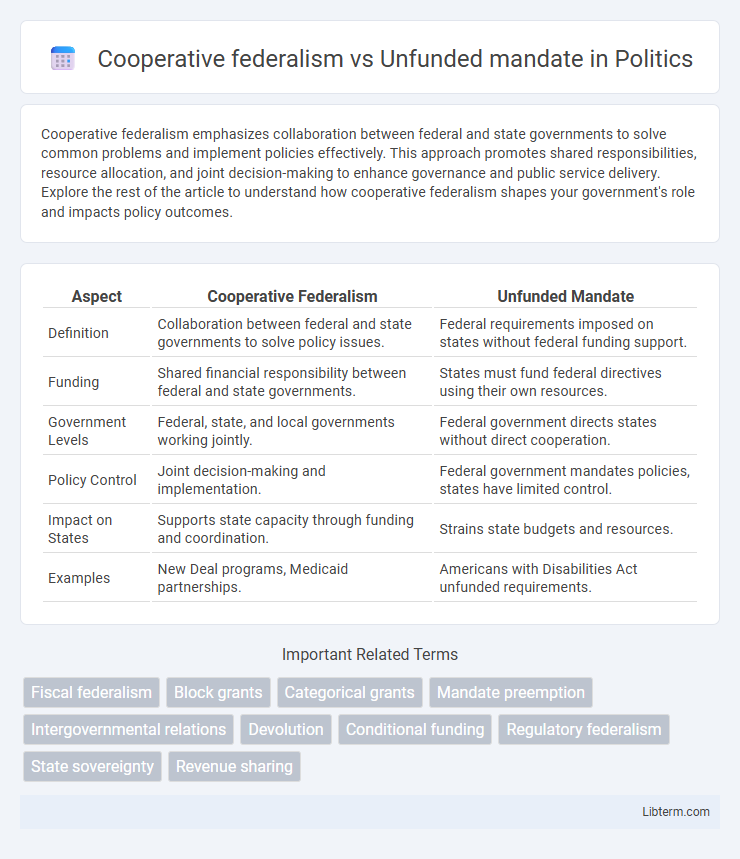Cooperative federalism emphasizes collaboration between federal and state governments to solve common problems and implement policies effectively. This approach promotes shared responsibilities, resource allocation, and joint decision-making to enhance governance and public service delivery. Explore the rest of the article to understand how cooperative federalism shapes your government's role and impacts policy outcomes.
Table of Comparison
| Aspect | Cooperative Federalism | Unfunded Mandate |
|---|---|---|
| Definition | Collaboration between federal and state governments to solve policy issues. | Federal requirements imposed on states without federal funding support. |
| Funding | Shared financial responsibility between federal and state governments. | States must fund federal directives using their own resources. |
| Government Levels | Federal, state, and local governments working jointly. | Federal government directs states without direct cooperation. |
| Policy Control | Joint decision-making and implementation. | Federal government mandates policies, states have limited control. |
| Impact on States | Supports state capacity through funding and coordination. | Strains state budgets and resources. |
| Examples | New Deal programs, Medicaid partnerships. | Americans with Disabilities Act unfunded requirements. |
Defining Cooperative Federalism
Cooperative federalism refers to a system where national, state, and local governments collaborate to solve common problems, sharing powers, resources, and responsibilities. This approach contrasts with unfunded mandates, which occur when the federal government requires states to perform certain actions without providing the necessary funding. Cooperative federalism emphasizes joint planning, financial assistance, and coordinated policy implementation across government levels.
Understanding Unfunded Mandates
Unfunded mandates are regulations or new laws imposed by the federal government on state or local governments without providing corresponding funding, creating financial burdens. Cooperative federalism emphasizes collaboration between federal and state authorities, often involving federal funds to support shared programs. Understanding unfunded mandates highlights the tension in cooperative federalism when states must execute federally dictated policies without adequate resources.
Historical Evolution of Federal-State Relations
Cooperative federalism emerged during the New Deal era as a response to the economic crisis, fostering collaboration between federal and state governments through shared programs and funding. In contrast, unfunded mandates have a more recent history, gaining prominence in the late 20th century when federal legislation imposed requirements on states without providing financial resources. This shift marked a tension in federal-state relations, highlighting the evolving balance between national priorities and state autonomy.
Key Principles of Cooperative Federalism
Cooperative federalism emphasizes collaboration between federal, state, and local governments to achieve shared policy goals through joint funding and administration, promoting flexibility and mutual benefits. It relies on mechanisms like grants-in-aid and revenue sharing to encourage states' participation while respecting their autonomy. Unlike unfunded mandates that impose federal requirements without financial support, cooperative federalism fosters partnership and resource-sharing to address complex governance challenges efficiently.
Challenges Posed by Unfunded Mandates
Unfunded mandates create significant challenges for cooperative federalism by imposing federal requirements on state and local governments without providing corresponding financial support. This financial strain forces states to divert resources from other essential programs or raise taxes, undermining fiscal autonomy and policy flexibility. The resulting tension complicates collaboration between federal and state governments, hindering effective governance and program implementation.
Financial Implications for States
Cooperative federalism involves shared financial responsibilities between federal and state governments, with funds typically provided through grants-in-aid to support state programs, reducing the fiscal burden on states. Unfunded mandates, however, impose federal requirements on states without accompanying financial assistance, forcing states to allocate limited resources from their budgets to comply. The financial implications for states under unfunded mandates often result in budget reallocations, increased state taxes, or cuts in other essential services.
Examples Illustrating Cooperative Federalism
Cooperative federalism is exemplified by programs like Medicaid, where federal and state governments share funding and administrative responsibilities to provide healthcare services. The Clean Air Act also illustrates this system, as the federal government sets air quality standards, while states develop and enforce their own plans to meet these targets. These examples contrast with unfunded mandates, where the federal government imposes requirements on states without supplying corresponding financial support.
Notable Cases of Unfunded Mandates
Notable cases of unfunded mandates include *New York v. United States* (1992), where the Supreme Court ruled federal government cannot compel states to enforce federal regulations without funding. Another key case, *Printz v. United States* (1997), struck down federal requirements forcing state officials to conduct background checks under the Brady Handgun Violence Prevention Act without federal financial support. These cases highlight conflicts between cooperative federalism's shared governance and the burden of unfunded mandates on state resources.
Policy Impacts and Governance Outcomes
Cooperative federalism promotes shared policy implementation and resource allocation between federal and state governments, enhancing collaboration and flexible governance outcomes. Unfunded mandates impose federal requirements on states without financial support, often leading to budgetary strain and reduced policy effectiveness at the state level. The contrast in governance impacts highlights cooperative federalism's ability to foster intergovernmental partnerships, whereas unfunded mandates can foster conflict and hinder state autonomy.
Future Directions in Federal-State Collaboration
Future directions in federal-state collaboration emphasize enhancing cooperative federalism by increasing grant flexibility and promoting joint policy innovation to address complex challenges. Shifting away from unfunded mandates, the federal government aims to provide clearer funding streams and shared accountability to support state initiatives effectively. Strengthening intergovernmental partnerships fosters adaptive governance models that align national priorities with state capacities for sustainable outcomes.
Cooperative federalism Infographic

 libterm.com
libterm.com